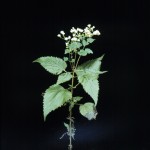White Snakeroot
Ageratina altissima (L.) R.M. King & H. Rob.
Asteraceae (Sunflower Family)
Description
White Snakeroot is an erect, opposite-branching, herbaceous perennial growing to 1 to 4 feet or 0.3 to 1.2 m tall. It arises from a fibrous root crown that may have short rhizomes. The slender, round stems tend to be purplish, especially when growing in the open. The opposite leaves have three distinct veins and coarsely toothed margins, with the upper ones being stalkless. Leaves are broadly ovate in shape and have long petioles. Small clusters of white flowers are produced at the ends of the branches in loose, terminal, and flat-topped clusters. The flowers point upward and are tuft-like in appearance. Bracts of the involucre (i.e., leafy appendages at the base of the flower) are pointed and hairless. Bloom time occurs from July to October.Habitat
White Snakeroot is most frequently found in wooded areas but may persist after clearing. Dense populations are found on the floors, slopes, and walls of hill country canyons with northern exposures. These plants are found in the east, southeast, and north central Texas. White Snakeroot may occur in rocky woods, bottomland forests, bases/ledges of bluffs, clearings, banks of waterways, pastures, old field sites, roadsides, and disturbed areas.Toxic Agent
The toxic agent of White Snakeroot is tremetone, which affects all animals, including humans. It is efficiently passed into the milk of livestock, which protects the lactating female but poisons the young. The tremetol content is highest in green plants but remains toxic even when dried. Most White Snakeroot poisonings in Texas occur in sheep and especially in goats, where the lethal dose is only about 0.5 percent of an animal's body weight. Consumption of 0.5 to 2 percent of body weight in the green plant is associated with symptoms of intoxication in livestock. Animals raised in pastures with the plant avoid it and are seldom poisoned. Introducing naive goats to the plant in the spring has caused death losses of more than 90 percent.Signs of Livestock Ingestion
Clinical signs of snakeroot poisoning, although similar, vary with the species affected. Signs in sheep and goats are predominately those of liver failure, but include Depression, Weakness, Head pressing, Slight muscle tremors after exercise, Coma, and Death in 1 to 5 days. For cattle, White Snakeroot intoxication is often referred to as “trembles” due to the characteristic of muscle tremors. Muscle tremors are most severe in the muzzle and legs and can occur after exercise. In cattle, the signs include Depression, Lethargy, Ketosis, Constipation, Listlessness, Stiff movements, Severe muscle tremors after exercise, Coma, and Death in 2 to 10 days. Horses show clinical signs similar to those of cattle except that there are also some signs related to disrupted cardiac function (abnormal heart rate, jugular distension, and ventral edema), and death can occur in 1 to 2 days. For horses, intoxication is often associated with congestive heart failure. Symptoms can include sweating, stumbling, depression, disrupted cardiac function, and difficulty swallowing. Muscle tremors are inconsistently observed in horses. Mortality in livestock is high from White Snakeroot intoxication. Exercise and excitement should be avoided. Lactating animals should be milked frequently, and the milk should be discarded.Management Strategies
Goats naive to White Snakeroot should never be allowed access to it except in midwinter when there are no green plants. Cattle and horses should not be forced to consume the plant because of poor range conditions. Many cattle showing signs of tremors will recover if they are moved from contaminated pastures and allowed to remain quiet with as little disturbance as possible.Images
Plant Characteristics
Flower Color: White
Seed Type: Non-Encapsulated
Duration: Perennial
Stem Texture: Hairless/Smooth
Growth Habit: Forbs/Broadleaf
Leaf Shape
 : Simple and Toothed
: Simple and Toothed
Season: Warm
Distribution
 : 01 - Pineywoods, 02 - Gulf Prairies and Marshes, 03 - Post Oak Savannah, 04 - Blackland Prairies, 06 - South Texas Plains, 07 - Edwards Plateau
: 01 - Pineywoods, 02 - Gulf Prairies and Marshes, 03 - Post Oak Savannah, 04 - Blackland Prairies, 06 - South Texas Plains, 07 - Edwards Plateau
Distributions
Distribution refers to the ecological region in Texas that a plant has been found. You can also view a clickable map.
Book: Toxic Plants of Texas (B-6105)
Collection: Toxics, Wild Flowers
Livestock Affected: Cattle, Goats, Horses, Sheep
Livestock Signs: Abnormal Heartbeat, Coma, Constipation, Depression/ Weakness, Difficulty Swallowing, Incoordination, Ketosis, Lethargy/Listlessness, Pushing On Objects, Stiffness, Sweating, Trembling





